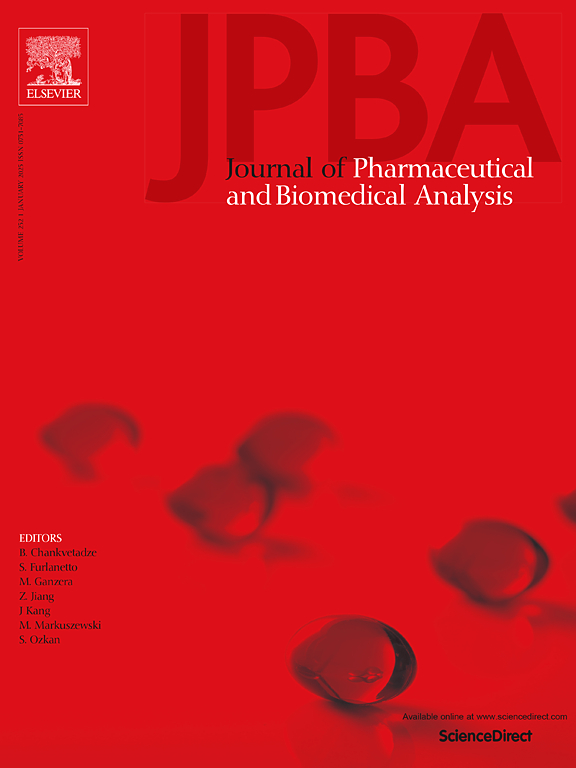Characterization of pneumococcal conjugates in vaccine process development by multi-detection hydrodynamic chromatography
IF 3.1
3区 医学
Q2 CHEMISTRY, ANALYTICAL
Journal of pharmaceutical and biomedical analysis
Pub Date : 2025-03-20
DOI:10.1016/j.jpba.2025.116826
引用次数: 0
Abstract
Pneumococcal conjugate vaccines (PCVs) are developed by conjugating pneumococcal polysaccharides to a carrier protein, such as CRM197. Size and molecular weight are important attributes of each monovalent conjugate in a PCV, making accurate monitoring of molecular weights crucial during the conjugation process. While size-exclusion chromatography (SEC) coupled with multi-angle light scattering (MALS), refractive index (RI), and ultraviolet (UV) detectors (SEC-MALS) is the gold standard used for absolute molecular weight characterization, this study presents the development of a multi-detection (MALS, UV and RI) hydrodynamic chromatography (HDC-MALS) method and its utility for comprehensive PCV characterization. The optimized HDC-MALS method is employed for in-depth understanding of vaccine conjugation process and effective characterization of heterogeneous, large conjugates through granular molar mass distribution analysis. Compared to other mild separation techniques such as field flow fractionation (FFF), HDC allows for high mobile phase flow rates without compromising separation efficiency, enabling faster run times that meet the demands of in-process control with rapid turn-around times.
多检测水动力色谱法对肺炎球菌疫苗研制过程中结合物的表征
肺炎球菌结合疫苗(PCVs)是通过将肺炎球菌多糖与载体蛋白(如CRM197)结合而开发的。尺寸和分子量是PCV中每个单价偶联物的重要属性,因此在偶联过程中精确监测分子量至关重要。虽然尺寸排除色谱(SEC)结合多角度光散射(MALS)、折射率(RI)和紫外线(UV)检测器(SEC-MALS)是绝对分子量表征的金标准,但本研究提出了一种多检测(MALS、UV和RI)水动力色谱(hdl -MALS)方法的发展及其在PCV综合表征中的应用。优化后的hplc - mals方法可深入了解疫苗偶联过程,并通过颗粒摩尔质量分布分析有效表征异质大偶联物。与其他温和的分离技术(如场流分馏(FFF))相比,HDC允许高流动相流速而不影响分离效率,从而实现更快的运行时间,满足快速周转时间的过程控制需求。
本文章由计算机程序翻译,如有差异,请以英文原文为准。
求助全文
约1分钟内获得全文
求助全文
来源期刊
CiteScore
6.70
自引率
5.90%
发文量
588
审稿时长
37 days
期刊介绍:
This journal is an international medium directed towards the needs of academic, clinical, government and industrial analysis by publishing original research reports and critical reviews on pharmaceutical and biomedical analysis. It covers the interdisciplinary aspects of analysis in the pharmaceutical, biomedical and clinical sciences, including developments in analytical methodology, instrumentation, computation and interpretation. Submissions on novel applications focusing on drug purity and stability studies, pharmacokinetics, therapeutic monitoring, metabolic profiling; drug-related aspects of analytical biochemistry and forensic toxicology; quality assurance in the pharmaceutical industry are also welcome.
Studies from areas of well established and poorly selective methods, such as UV-VIS spectrophotometry (including derivative and multi-wavelength measurements), basic electroanalytical (potentiometric, polarographic and voltammetric) methods, fluorimetry, flow-injection analysis, etc. are accepted for publication in exceptional cases only, if a unique and substantial advantage over presently known systems is demonstrated. The same applies to the assay of simple drug formulations by any kind of methods and the determination of drugs in biological samples based merely on spiked samples. Drug purity/stability studies should contain information on the structure elucidation of the impurities/degradants.

 求助内容:
求助内容: 应助结果提醒方式:
应助结果提醒方式:


